Search Thermo Fisher Scientific
Invitrogen
CX3CL1 (Fractalkine) Polyclonal Antibody, eBioscience™
This Antibody was verified by Cell treatment to ensure that the antibody binds to the antigen stated.
FIGURE: 1 / 6
CX3CL1 (Fractalkine) Antibody (14-7986-81) in WB
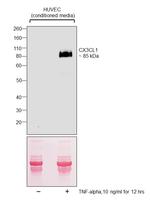
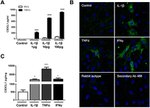
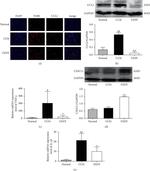
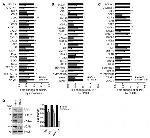
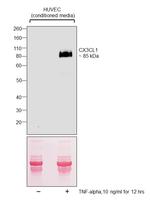

Product Details
14-7986-81
Species Reactivity
Published species
Host/Isotype
Class
Type
Conjugate
Form
Concentration
Purification
Storage buffer
Contains
Storage conditions
Shipping conditions
RRID
Product Specific Information
Description: The rabbit polyclonal antibody reacts with recombinant and natural mouse, rat, and human fractalkine (CX3CL1); the antibody was generated using E. coli-expressed chemotactic domain of human CX3CL1 as an immunogen. CX3CL1, also known as neurotactin or fractalkine, is a membrane-bound CX3C chemokine. The mature protein is part of a 397-amino acid precursor and consists of a chemokine domain of 76 amino acids, a mucin stalk of 241 amino acids, a putative transmembrane domain of 18 amino acids, and an intracellular tail of 37 amino acids. Within the chemokine domain, the first two cysteine residues are separated by 3 amino acids (CX3C). CX3CL1 message is found in high abundance in the brain, kidney, lung and heart tissues. CX3CL1 is chemotactic for monocytes and other leukocytes including NK cells and may play a role in brain inflammation.
Applications Reported: This polyclonal has been reported for use in immunoblotting (WB), immunoprecipitation, and immunohistochemistry. Cross-reactivity to CX3CL1 of other species has not been determined.
Applications Tested: To achieve best results, titrate antibody by dilution for each application as follows:
Western Blot 1:1000-1:5000
Immunoprecipitation 1:300-1:800
Immunohistochemistry 1:100-1:500.
Purity: Greater than 90%, as determined by SDS-PAGE.
Aggregation: Less than 10%, as determined by HPLC.
Filtration: 0.2 µm post-manufacturing filtered.
Target Information
Chemokines are a family of proteins associated with the trafficking of leukocytes in immune surveillance and inflammatory cell recruitment. They are classified based on the positions of key cysteine residues. CX3CL1 is a CX3C chemokine known to induce adhesion and migration of leukocytes mediated by a membrane-bound and soluble form respectively. Recent experiments have shown that CX3CL1 can suppress the production of nitrous oxide, interleukin-6, and TNF-a in activated microglia and neuronal cells, suggesting that it may act as an intrinsic inhibitor against neurotoxicity by activated microglia. Its receptor, CX3CR1, also functions as a co-receptor for HIV-1 and HIV-2 envelope fusion and virus infection, which can be inhibited by CX3CL1.
For Research Use Only. Not for use in diagnostic procedures. Not for resale without express authorization.
Bioinformatics
Protein Aliases: ABCD-3; C-X3-C motif chemokine 1; chemokine (C-X3-C motif) ligand 1; CX3C membrane-anchored chemokine; FK; Fractalkine; Neurotactin; small inducible cytokine subfamily D (Cys-X3-Cys), member 1 (fractalkine, neurotactin); small inducible cytokine subfamily D (Cys-X3-Cys), member-1; small inducible cytokine subfamily D, 1; Small-inducible cytokine D1
Gene Aliases: A-152E5.2; AB030188; ABCD-3; Acc1; AI848747; C3Xkine; CX3C; CX3CL1; CXC3; CXC3C; D8Bwg0439e; FKN; fractalkine; neurotactin; NTN; NTT; SCYD1
UniProt ID: (Human) P78423, (Rat) O55145, (Mouse) O35188
Entrez Gene ID: (Human) 6376, (Rat) 89808, (Mouse) 20312

Performance Guarantee
If an Invitrogen™ antibody doesn't perform as described on our website or datasheet,we'll replace the product at no cost to you, or provide you with a credit for a future purchase.*
Learn more
We're here to help
Get expert recommendations for common problems or connect directly with an on staff expert for technical assistance related to applications, equipment and general product use.
Contact tech support
